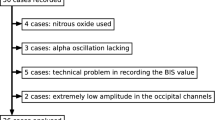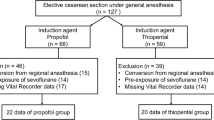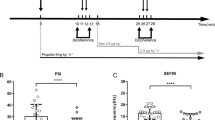Abstract
Objective
A variety of effects of surgical incision on the electroencephalogram (EEG) during modern general anesthesia have been previously described; including both increases and decreases in both high and low frequencies in the EEG. What are the patterns commonly seen during routine clinical anesthesia?
Methods
We analyzed pre-frontal EEG data from a previously published study (116 adult patients having general anesthesia maintained with either desflurane or propofol) (Leslie et al. in Anesthesiology 111:547–555, 2009), The EEG was quantified using seven estimated parameters: slope and intercept of the underlying non-oscillatory (logarithmically transformed) power spectrum, amplitude and frequency of the episodic frontal alpha (EFA) oscillation, peak power in the delta waveband, high frequency variability index, and bispectral index (BIS). We compared a 30 s EEG segment from 2 min before, with that 2 min after the surgical incision.
Results
The pre-incision EEGs showed a wide spread of different values for the estimated EEG parameters, but the propofol group had increased EFA amplitude. Incision was associated with decreased EFA activity (p = 0.0004), and high frequency variability (p = 0.04, repeated measures ANOVA). The effects of the incision were independent of the type of drug used for maintenance of anesthesia, and on the pre-incision BIS. The loss of EFA tended to be associated with an increase in delta power (r = -0.39, p < 0.0001).
Conclusions
During anesthesia maintained with desflurane or propofol, surgical incision has modest effects on the EEG patterns. It does not cause an increase in high frequency power; the most consistent changes are a loss of EFA amplitude and burst suppression patterns. This effect is not strongly modified by the depth of anesthesia—as estimated by the BIS.
Similar content being viewed by others
References
Leslie K, Sleigh J, Paech MJ, Voss L, Lim CW, Sleigh C. Dreaming and electroencephalographic changes during anesthesia maintained with propofol or desflurane. Anesthesiology. 2009;111:547–55.
Bischoff P, Kochs E, Haferkorn D, Schulte am Esch J. Intraoperative EEG changes in relation to the surgical procedure during isoflurane-nitrous oxide anesthesia: hysterectomy versus mastectomy. J Clin Anesth. 1996;8:36–43.
Dutton RC, Smith WD, Smith NT. EEG Predicts movement response to surgical stimuli during general anesthesia with combinations of isoflurane, 70% N2O, and fentanyl. J Clin Monit. 1996;12:127–39.
Hagihira S, Takashina M, Mori T, Ueyama H, Mashimo T. Electroencephalographic bicoherence is sensitive to noxious stimuli during isoflurane or sevoflurane anesthesia. Anesthesiology. 2004;100:818–25.
Hayashi K, Sawa T, Matsuura M. Anesthesia depth-dependent features of electroencephalographic bicoherence spectrum during sevoflurane anesthesia. Anesthesiology. 2008;108:841–50.
Kochs E, Bischoff P, Pichlmeier U. Schulte am Esch J. Surgical stimulation induces changes in brain electrical activity during isoflurane/nitrous oxide anesthesia. A topographic electroencephalographic analysis. Anesthesiology. 1994;80:1026–34.
Kox WJ, von Heymann C, Heinze J, Prichep LS, John ER, Rundshagen I. Electroencephalographic mapping during routine clinical practice: cortical arousal during tracheal intubation? Anesthesia Analgesia. 2006;102:825–31.
Morimoto Y, Matsumoto A, Koizumi Y, Gohara T, Sakabe T, Hagihira S. Changes in the bispectral index during intraabdominal irrigation in patients anesthetized with nitrous oxide and sevoflurane. Anesthesia Analgesia. 2005;100:1370–4.
Otto KA, Mally P. Noxious stimulation during orthopaedic surgery results in EEG ‘arousal’ or ‘paradoxical arousal’ reaction in isoflurane-anesthetised sheep. Res Vet Sci. 2003;75:103–12.
Seitsonen ER, Korhonen IK, van Gils MJ, et al. EEG spectral entropy, heart rate, photoplethysmography and motor responses to skin incision during sevoflurane anesthesia. Acta Anesthesiol Scand. 2005;49:284–92.
Gibson TJ, Johnson CB, Stafford KJ, Mitchinson SL, Mellor DJ. Validation of the acute electroencephalographic responses of calves to noxious stimulus with scoop dehorning. N Z Vet J. 2007;55:152–7.
Rundshagen I, Schroder T, Heinze J, Prichep L, John ER, Kox WJ. Topographic electroencephalography: endotracheal intubation during anesthesia with propofol/fentanyl. Anasthesiol Intensivmed Notfallmed Schmerzther. 2005;40:633–9.
Wolter S, Friedel C, Bohler K, Hartmann U, Kox WJ, Hensel M. Presence of 14 Hz spindle oscillations in the human EEG during deep anesthesia. Clin Neurophysiol. 2006;117:157–68.
Ferenets R, Lipping T, Suominen P, et al. Comparison of the properties of EEG spindles in sleep and propofol anesthesia. Conf Proc IEEE Eng Med Biol Soc. 2006;1:6356–9.
Mukovski M, Chauvette S, Timofeev I, Volgushev M. Detection of active and silent states in neocortical neurons from the field potential signal during slow-wave sleep. Cereb Cortex. 2007;17:400–14.
MacKay EC, Sleigh JW, Voss LJ, Barnard JP. Episodic waveforms in the electroencephalogram during general anesthesia: a study of patterns of response to noxious stimuli. Anesthesia Intens Care. 2010;38:102–12.
Antognini JF, Carstens E. In vivo characterization of clinical anesthesia and its components. Br J Anesth. 2002;89:156–66.
Alkire MT. Loss of effective connectivity during general anesthesia. Int Anesthesiol Clin. 2008;46:55–73.
Alkire MT, Hudetz AG, Tononi G. Consciousness and anesthesia. Science. 2008;322:876–80.
Fuentealba P, Timofeev I, Bazhenov M, Sejnowski TJ, Steriade M. Membrane bistability in thalamic reticular neurons during spindle oscillations. J Neurophysiol. 2005;93:294–304.
Steriade M. Grouping of brain rhythms in corticothalamic systems. Neuroscience. 2006;137:1087–106.
Steriade M, McCormick DA, Sejnowski TJ. Thalamocortical oscillations in the sleeping and aroused brain. Science. 1993;262:679–85.
Robinson RB, Siegelbaum SA. Hyperpolarization-activated cation currents: from molecules to physiological function. Annu Rev Physiol. 2003;65:453–80.
Franks NP. General anesthesia: from molecular targets to neuronal pathways of sleep and arousal. Nat Rev Neurosci. 2008;9:370–86.
Author information
Authors and Affiliations
Corresponding author
Additional information
Sleigh JW, Leslie K, Voss L. The effect of skin incision on the electroencephalogram during general anesthesia maintained with propofol or desflurane.
Rights and permissions
About this article
Cite this article
Sleigh, J.W., Leslie, K. & Voss, L. The effect of skin incision on the electroencephalogram during general anesthesia maintained with propofol or desflurane. J Clin Monit Comput 24, 307–318 (2010). https://doi.org/10.1007/s10877-010-9251-3
Received:
Accepted:
Published:
Issue Date:
DOI: https://doi.org/10.1007/s10877-010-9251-3




